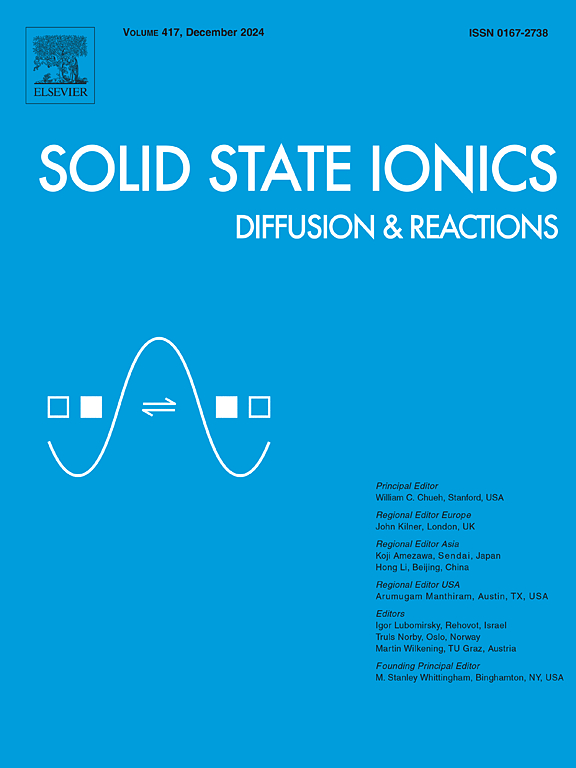铋取代对铌酸钡锌结构、电学和介电性能的影响
IF 3.3
4区 材料科学
Q3 CHEMISTRY, PHYSICAL
引用次数: 0
摘要
本文报道了铋取代对BaZn0.33Nb0.67-xBixO3-δ (BZNBi, x = 0,0.017, 0.03, 0.05)结构、电学和介电性能的影响。BZNBi钙钛矿氧化物以立方Pm3 m对称结晶,但在x = 0.03和0.05样品中发现了少量的二次相。随着铋浓度的增加,观察到晶胞的膨胀,表明晶格常数与组成之间存在线性关系。BZNBi球团的表面微观结构表明,除了杂质含量显著的样品外,铋取代增强了致密化。在空气中600℃时,铋的引入使BZN的电导率从2.3×10−8Scm−1提高到3.1×10−2Scm−1。在1 MHz和600°C下,BZN的介电常数也从28增加到47,表明铋掺杂在改善BZN的电学和介电性能方面的潜力。本文章由计算机程序翻译,如有差异,请以英文原文为准。
Effect of bismuth substitution on structural, electrical and dielectric properties of barium zinc niobates
Herein, we report the effects of bismuth substitution on the structural, electrical, and dielectric properties of BaZn0.33Nb0.67-xBixO3-δ (BZNBi, x = 0, 0.017, 0.03, 0.05). BZNBi perovskite oxides crystallized in a cubic Pm3̅m symmetry, however, a minor secondary phase was found in x = 0.03, and 0.05 samples. An expansion of the unit cell was observed with increasing bismuth concentration, indicating a linear correlation between the lattice constant and composition. The surface microstructure of the BZNBi pellets revealed that bismuth substitution enhanced densification, except in samples with significant impurity content. The introduction of bismuth increased the electrical conductivity from in BZN to in BZNBi 0.05 at 600 °C in air. At 1 MHz and 600 °C, the dielectric constant also increased from 28 in BZN to 47 in BZNBi 0.017, indicating the potential of bismuth doping in improving the electrical and dielectric properties of BZN.
求助全文
通过发布文献求助,成功后即可免费获取论文全文。
去求助
来源期刊

Solid State Ionics
物理-物理:凝聚态物理
CiteScore
6.10
自引率
3.10%
发文量
152
审稿时长
58 days
期刊介绍:
This interdisciplinary journal is devoted to the physics, chemistry and materials science of diffusion, mass transport, and reactivity of solids. The major part of each issue is devoted to articles on:
(i) physics and chemistry of defects in solids;
(ii) reactions in and on solids, e.g. intercalation, corrosion, oxidation, sintering;
(iii) ion transport measurements, mechanisms and theory;
(iv) solid state electrochemistry;
(v) ionically-electronically mixed conducting solids.
Related technological applications are also included, provided their characteristics are interpreted in terms of the basic solid state properties.
Review papers and relevant symposium proceedings are welcome.
 求助内容:
求助内容: 应助结果提醒方式:
应助结果提醒方式:


